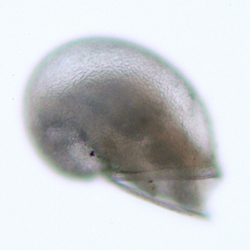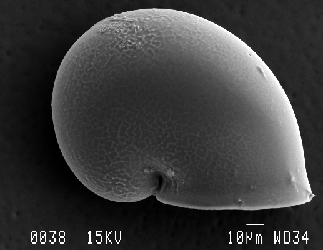

See also Figure 4A in Mullineaux et al., 1996


See also Figure 4A in Mullineaux et al., 1996
| Size under dissecting microscope:
170-180µm Size under compound microscope: 160, 170µm |
| Morphology: This is a small bulbous protoconch with overall fine reticulate sculpture. It has a straight aperture with a narrow rim which flares out all around. Seen from the side, the aperture and the lowest part of the base line up. From this angle the aperture measures about 2/3 of the total diameter of the shell. It resembles some of the Lacunoides protoconchs in the literature (especially L. vitreus from Juan de Fuca, Warén and Bouchet, 2001, p.167, Figure 29e), but neither of the described species has been reported from 9°N, to our knowledge. Because of the reticulate sculpture, we suspect that it is a neomphalid. |
| Frequency: Pump EPR 1999-2000: Occasional Pump EPR 2004: Common Trap EPR 2004-2005: Common |
Lepetodrilus spp. protoconch is the most likely to be confused with Unknown 5. They are of similar size and in both the apertures are straight and line up with the base of the shell. In Unknown 5, however, the aperture, when seen from the side, appears to take up about two thirds of the diameter of the shell, whereas in Lepetodrilus spp. it is about half. Unknown 5's aperture rim is narrower and it flares out to the sides and at the outer edge, whereas Lepetodrilus spp.'s does not. Lepetodrilus has pitted sculpture rather than reticulate, but this is not usually obvious under the light microscope. In the bottom photo showing both species, Unknown 5 is on the right. |
|
| Lepetodrilus-like protoconchs. These protoconchs have all the differences that Lepetodrilus spp. have and are about 15-20μm larger, as well. They generally lack an aperture rim. | |
| Benthic Unknown A is about 10µm smaller than Unknown 5, but is similar in appearance and also has reticulate sculpture. It has a slight left-hand twist, which tends to make it roll to expose the aperture. Unknown 5, however, is stable resting on its side. | |
Clypeosectus delectus (right) is similar in size to Unknown 5 and pointy apex is 15-20μm smaller. In neither does the aperture form a straight line with the base and they both have coarse pitted sculpture, rather than reticulate. |
Go to:
Home
Gastropods by Size
Gastropods by Species
Other Taxa